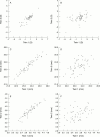The importance of genes and environment for ocular refraction and its determiners: a population based study among 20-45 year old twins
- PMID: 11734523
- PMCID: PMC1723806
- DOI: 10.1136/bjo.85.12.1470
The importance of genes and environment for ocular refraction and its determiners: a population based study among 20-45 year old twins
Abstract
Aims: To estimate the heritability for ocular refraction and its determiners in a population based cohort of 20-45 years old twins.
Methods: 114 twin pairs (53 monozygotic and 61 dizygotic) participated. Refraction was determined in cycloplegia and eye dimensions were measured with ultrasound. Educational length was assessed. The heritability was estimated employing aetiological model fitting. Evidence of gene-environment interaction was analysed. Correlations between intrapairwise differences in educational length and in refraction were evaluated.
Results: The heritability was between 0.89 and 0.94 (95% CI: 0.82, 0.96) for refraction, total refraction, axial length, and radius of corneal curvature. Phenotypic variation was mostly due to additive genetic effects. Refraction revealed evidence of gene-environment interaction (r = -0.29 to -0.32; p <0.05). The heritability for anterior chamber depth and lens thickness was between 0.88 and 0.94 (95% CI: 0.81, 0.96) and dominant genetic effects were the most likely explanation. There was no correlation between age and intrapairwise differences in refraction. The dizygotic twins had significant larger intrapairwise differences in educational length (p <0.05), but the differences were not correlated with differences in refraction.
Conclusions: The results indicate a high heritability for ocular refraction and its determiners and thus suggest that environmental impact on refraction is not significant. However, the epidemiological association between educational length (near work) and myopia, the evidence of increasing myopia prevalence within a few generations, and the theory of gene-environment interaction imply that some individuals might be genetically liable to develop myopia if exposed to certain environmental factors.
Figures





References
Publication types
MeSH terms
LinkOut - more resources
Full Text Sources
Molecular Biology Databases
